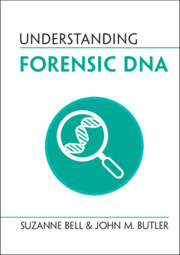Book contents
- Understanding Forensic DNA
- Understanding Life
- Understanding Forensic DNA
- Copyright page
- Reviews
- Dedication
- Contents
- Foreword
- Preface
- Acknowledgments
- 1 Biological Identification
- 2 Before DNA
- 3 First-Generation Forensic DNA
- 4 STR Methods and Loci
- 5 DNA Analysis and Interpretation: Single-Source Samples and Simple Mixtures
- 6 The Curse of Sensitivity
- 7 From Mothers and Fathers
- 8 Emerging Technologies
- 9 Emerging Issues
- Concluding Remarks
- Summary of Common Misunderstandings
- References and Further Reading
- Figure Credits
- Index
1 - Biological Identification
Published online by Cambridge University Press: 02 September 2022
- Understanding Forensic DNA
- Understanding Life
- Understanding Forensic DNA
- Copyright page
- Reviews
- Dedication
- Contents
- Foreword
- Preface
- Acknowledgments
- 1 Biological Identification
- 2 Before DNA
- 3 First-Generation Forensic DNA
- 4 STR Methods and Loci
- 5 DNA Analysis and Interpretation: Single-Source Samples and Simple Mixtures
- 6 The Curse of Sensitivity
- 7 From Mothers and Fathers
- 8 Emerging Technologies
- 9 Emerging Issues
- Concluding Remarks
- Summary of Common Misunderstandings
- References and Further Reading
- Figure Credits
- Index
Summary
Forensic DNA typing was developed to improve our ability to conclusively identify an individual and distinguish that person from all others. Current DNA profiling techniques yield incredibly rare types, but definitive identification of one and only one individual using a DNA profile remains impossible. This fact may surprise you, as there is a popular misconception that a DNA profile is unique to an individual, with the exception of identical twins. You may be the only person in the world with your DNA profile, but we cannot know this short of typing everyone. What we can do is calculate probabilities. The result of a DNA profile translates into the probability that a person selected at random will have that same profile. In most cases, this probability is astonishingly tiny. Unfortunately, this probability is easily misinterpreted, a situation we will see and discuss many times in the coming chapters.
Keywords
- Type
- Chapter
- Information
- Understanding Forensic DNA , pp. 1 - 16Publisher: Cambridge University PressPrint publication year: 2022

